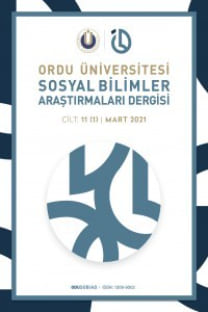Enflasyon, Döviz Kuru, Faiz Oranı ve Para Arzı Arasındaki İlişki: Türkiye’den Kanıtlar
Son dönemde COVID-19 Salgını ile başlayan ve Rusya-Ukrayna Savaşı ile devam eden süreç küresel ekonominin sorunlar yaşamasına neden olmuştur. Pandemi ile yaşanan tedarik zincirindeki bozulmaların ardından savaşın neden olduğu enerji fiyatlarındaki yükselmeler ülkelerin temel makroekonomik değişkenlerini etkilemiştir. Bu süreçte en çok etkilenen gösterge olan enflasyonla mücadele noktasında ekonomi otoriterleri para ve maliye politikaları araçlarını kullanmaya başlamışlardır. Bu bağlamda çalışmanın amacı Türkiye’nin 2000:1-2022:9 döneminde enflasyon oranı ile döviz kuru, faiz oranı ve para arzı arasındaki ilişkiyi incelemektir. Bu amaç doğrultusunda çalışmada kayan pencere zamana göre değişen nedensellik testi kullanılmıştır. Elde edilen bulgulara göre, değişkenler arasında en güçlü ilişkinin para arzı ile enflasyon oranı arasında olduğunu görülürken, en zayıf ilişkinin ise faiz oranı ile enflasyon oranı ve döviz kuru ile para arzı arasında olduğu görülmektedir. Bu ilişkilerin dönemlerini incelediğimizde ise son dönemde ön plana çıkan ilişkinin döviz kurundan enflasyon oranına ve para arzından enflasyon oranına doğru olduğunu söyleyebiliriz. Bu sonuçlar enflasyonla mücadele konusunda en önemli faktörlerin döviz kuru ve para arzı olduğunu göstermektedir. Politika yapıcı ve karar alıcılara enflasyonla mücadele konusunda döviz kurunda ve para arzında istikrarını sağlamaya yönelik adımlar atılması gerektiğini belirtebiliriz.
Anahtar Kelimeler:
Enflasyon oranı, Faiz oranı, Döviz kuru, Para arzı, Zamana göre değişen nedensellik, Inflation rate, Interest rate, Exchange rate, Money supply, Time-varying causality
The Relationship between Inflation, Exchange Rate, Interest Rate and Money Supply: Evidence from Turkey
The process that started with the COVID-19 Epidemic and continued with the Russia-Ukraine War has caused the global economy to experience problems. After the disruptions in the supply chain experienced with the pandemic, the rise in energy prices caused by the war affected the main macroeconomic variables of the countries. In this process, economic authorities have started to use monetary and fiscal policy tools the point of fighting inflation, which is the most affected indicator. In this context, the aim of the study is to examine the relationship between the inflation rate, exchange rate, interest rate, and money supply in Turkey's 2000:1-2022:9 period. For this purpose, the rolling window time-varying causality test was used in the study. According to the findings, it is seen that the strongest relationship among the variables is between money supply and inflation rate, while the weakest relationship is between interest rate and inflation rate and exchange rate and money supply. When we examine the periods of these relations, we can say that the relationship that has come to the fore in the last period is from the exchange rate to the inflation rate and from the money supply to the inflation rate. These results show that the most important factors in the fight against inflation are the exchange rate and money supply. We can indicate to policymakers and decision-makers that steps should be taken to ensure the stability of the exchange rate and money supply in the fight against inflation.
Keywords:
Inflation rate, Interest rate, Exchange rate, Money supply, Time-varying causality,
___
- Mishkin, F. (2018). Makroekonomi (S. Sezgin & M. Şentürk (eds.); 2nd ed.). Nobel.
- Mpofu, R. T. (2011). Money supply, interest rate, exchange rate and oil price influence on inflation in South Africa. Corporate Ownership and Control, 8(3), 594–605.
- Nguyen, V. B. (2015). Effects of fiscal deficit and money M2 supply on inflation: Evidence from selected economies of Asia. Journal of Economics, Finance and Administrative Science, 20(38), 49–53. https://doi.org/http://dx.doi.org/10.1016/j.jefas.2015.01.002
- Ongan, S., & Gocer, I. (2019). Re-considering the Fisher equation for South Korea in the application of nonlinear and linear ARDL models. Quantitative Finance and Economics, 3(1), 75–87. https://doi.org/10.3934/qfe.2019.1.75
- Örnek, İ., & Uğur, B. (2016). Küresel kriz sürecinde gelişmiş ve gelişmekte olan ekonomilerde para politikaları. Çukurova Üniversitesi İktisadi ve İdari Bilimler Fakültesi Dergisi, 20(1), 209–235. ttps://dergipark.org.tr/en/pub/cuiibfd/issue/34473/385980
- Özmen, M., Karlılar, S., & Karlılar, G. (2017). Türkiye için döviz kuru, faiz ve enflasyonun hisse senedi getirileri üzerine etkileri. Çukurova Üniversitesi İktisadi ve İdari Bilimler Fakültesi Dergisi, 21(1), 107–120.
- Phillips, P. C. B., Shi, S., & Yu, J. (2015). Testıng for Multıple Bubbles: Hıstorıcal Epısodes of Exuberance and Collapse in the S&P 500. International Economic Review, 56(4), 1043–1078. https://doi.org/10.1111/iere.12132
- Ramadhani, R., & Nugroho, W. (2019). Analysis of the effect of exchange rates, e-money and ınterest rates on the amount of money supply and ıts ımplications on the ınflation level in Indonesia 2012-2017 period. International Journal of Accounting & Finance in Asia Pasific, 2(1), 1–17.
- Roshan, S. (2014). Inflation and Money supply growth in Iran: Empirical Evidences from Cointegration and Causality. Iranian Economic Review, 18(1), 131–152.
- Saraçoğlu, M., Kuzu, M., & Kocaoğlu, F. (2015). Türkiye ekonomisinde sermaye hareketleri, döviz kuru, enflasyon ve faiz arasındaki etkileşimlerin küresel ekonomi politik çerçevesinde analizi. Gazi İktisat ve İşletme Dergisi, 1(2), 75–110.
- ISSN: 1309-9302
- Yayın Aralığı: Yılda 3 Sayı
- Başlangıç: 2010
- Yayıncı: -
Sayıdaki Diğer Makaleler
Sosyal Medyada Z Kuşağına Yönelik Nefret Söylemi: Ekşi Sözlük Örneği
Hilal Özlem ABUŞOĞLU, Bahar BALCI AYDOĞAN
Yavuz Selim DÜGER, Tamer BAYRAM
Maarif Yıllıklarına Göre Balıkesir’de Eğitim (1950-1960)
Mânilerde Duygunun Estetik Ve Ontolojik Kodu Olarak Doğa
Yönetici ve Öğretmen Algılarına Göre Geleceğin Öğrenci ve Velileri: Bir Metafor Analizi Çalışması
Merve YALÇINKAYA, Neslin İHTİYAROĞLU
Mütevazı Liderlik ile Beyana Dayalı Kişisel İnisiyatif İlişkisinde Psikolojik Güvenliğin Aracı Rolü
Covid-19 Affects The US Economy Uncertainty?
